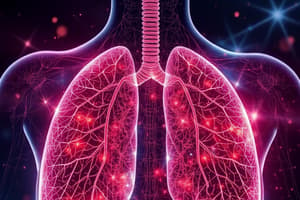Podcast
Questions and Answers
How do respiratory diseases such as asthma and COPD affect the process of cellular respiration?
How do respiratory diseases such as asthma and COPD affect the process of cellular respiration?
- They increase the production of ATP, leading to inefficient cellular respiration.
- They enhance the extraction of oxygen from the air, promoting cellular respiration.
- They have no impact on the process of cellular respiration.
- They decrease the availability of oxygen for cells, hindering cellular respiration. (correct)
What is the primary difference between fermentation and aerobic respiration?
What is the primary difference between fermentation and aerobic respiration?
- Fermentation takes place in the presence of oxygen, while aerobic respiration occurs in the absence of oxygen.
- Fermentation generates ATP, while aerobic respiration does not produce ATP.
- Fermentation produces ethanol or lactic acid, while aerobic respiration produces CO2 and H2O. (correct)
- Fermentation involves the extraction of energy from food molecules, while aerobic respiration does not.
Which measure can help maintain optimal respiratory function and efficient cellular respiration?
Which measure can help maintain optimal respiratory function and efficient cellular respiration?
- Exposing oneself to respiratory irritants to build immunity.
- Consuming high levels of sugary foods and beverages.
- Engaging in excessive weight lifting and anaerobic exercises.
- Avoiding exposure to air pollution and cigarette smoke. (correct)
Why is it important to seek early medical treatment for respiratory conditions like asthma and COPD?
Why is it important to seek early medical treatment for respiratory conditions like asthma and COPD?
What is the main purpose of maintaining a healthy weight and diet in relation to respiratory health?
What is the main purpose of maintaining a healthy weight and diet in relation to respiratory health?
Where does glycolysis take place in the cell?
Where does glycolysis take place in the cell?
What is the primary product of the Krebs cycle?
What is the primary product of the Krebs cycle?
Which stage of respiration involves the electron transport chain and chemiosmosis?
Which stage of respiration involves the electron transport chain and chemiosmosis?
What is the difference between aerobic respiration and anaerobic respiration?
What is the difference between aerobic respiration and anaerobic respiration?
What role do NADH and FADH2 play in cellular respiration?
What role do NADH and FADH2 play in cellular respiration?
Study Notes
Biology Respiration: The Crucial Process of Energy Conversion
Respiration is a fundamental biological process that allows living organisms to derive energy from the food we consume. It's a vital part of cellular life and involves various steps that transform food molecules into energy-rich ATP (adenosine triphosphate) molecules. In this article, we will explore the importance of respiration and how it's linked to respiratory diseases.
The Importance of Respiration
Respiration is the process that enables organisms to extract energy from food molecules like glucose and convert it into chemical energy stored in ATP. This energy is then used to power various cellular processes such as growth, reproduction, and metabolism. The process of respiration is divided into three stages: glycolysis, the Krebs cycle (also known as the citric acid cycle or TCA cycle), and oxidative phosphorylation (OXPHOS).
Glycolysis occurs in the cytosol and involves breaking down glucose into two molecules of pyruvate. The Krebs cycle takes place in the mitochondria and converts pyruvate into carbon dioxide, water, and a set of electron carriers—NADH and FADH2. OXPHOS occurs on the inner mitochondrial membrane and employs the electron transport chain and chemiosmosis to produce ATP.
Anaerobic Respiration and Fermentation
Anaerobic respiration is the process of breaking down glucose without the presence of oxygen. Fermentation is a type of anaerobic respiration that occurs in the absence of oxygen and involves the production of ethanol or lactic acid instead of CO2 and H2O. While fermentation provides a limited amount of energy, it doesn't generate ATP like aerobic respiration does.
Respiratory Disease
Respiratory diseases are conditions that affect the respiratory system, which includes the nose, throat, bronchi, and lungs. Some of the most common respiratory diseases include asthma, chronic obstructive pulmonary disease (COPD), and pneumonia. These conditions can affect the ability of the respiratory system to carry out the process of respiration efficiently, leading to reduced ATP production and a host of other health problems.
For example, asthma is a chronic inflammatory disease of the airways that can lead to decreased oxygen availability for cells. This reduction in oxygen availability can hinder the process of cellular respiration and negatively impact the body's energy production. Similarly, COPD is a group of lung diseases that result in the narrowing of the airways and decreased lung function, making it difficult for the body to extract oxygen from the air and deliver it to cells.
Prevention and Treatment of Respiratory Disease
Preventing and treating respiratory diseases can help maintain optimal respiratory function and ensure efficient cellular respiration. Measures that can help keep the respiratory system healthy include:
- Avoiding exposure to irritants and pollutants, such as cigarette smoke and air pollution.
- Exercising regularly to improve lung function and increase oxygen delivery to cells.
- Maintaining a healthy weight and diet to prevent obesity-related respiratory problems.
- Seeking medical treatment for respiratory conditions such as asthma and COPD, as early intervention can help slow the progression of the disease and reduce symptoms.
In conclusion, respiration is a vital process that enables living organisms to extract energy from food molecules in the form of ATP. Understanding the process of respiration and its connection to respiratory disease can help us appreciate the importance of maintaining optimal respiratory function. By taking steps to prevent and treat respiratory diseases, we can ensure that our cells receive the energy they need to function efficiently.
Studying That Suits You
Use AI to generate personalized quizzes and flashcards to suit your learning preferences.
Description
Explore the fundamental biological process of respiration and its link to respiratory diseases. Learn about the stages of respiration, anaerobic respiration, common respiratory diseases, and measures for prevention and treatment.




